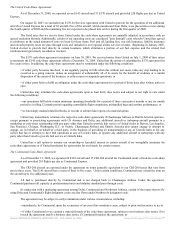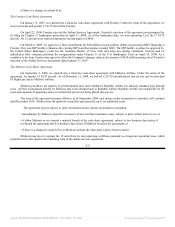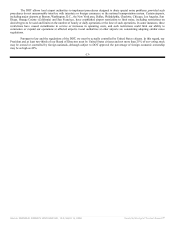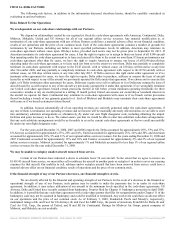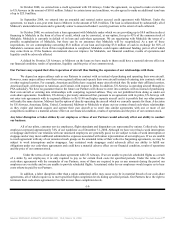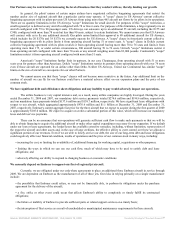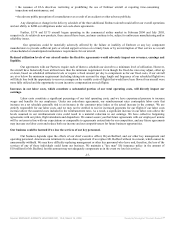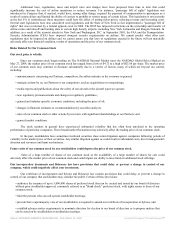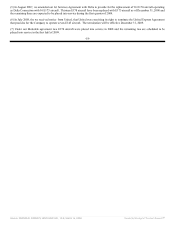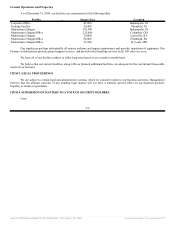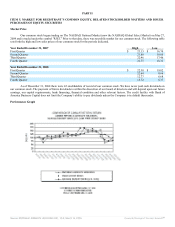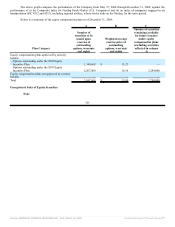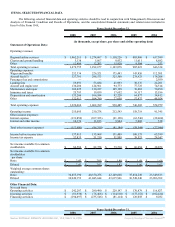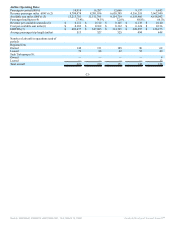Frontier Airlines 2008 Annual Report Download - page 30
Download and view the complete annual report
Please find page 30 of the 2008 Frontier Airlines annual report below. You can navigate through the pages in the report by either clicking on the pages listed below, or by using the keyword search tool below to find specific information within the annual report.
We may experience difficulty finding, training and retaining employees.
The airline industry has from time to time experienced a shortage of qualified personnel, specifically pilots and maintenance
technicians. In addition, as is common with most of our competitors, we have, from time to time, faced considerable turnover of our
employees. Although our employee turnover has decreased significantly since September 11, 2001, our pilots, flight attendants and
maintenance technicians sometimes leave to work for larger airlines, which generally offer higher salaries and more extensive benefit
programs than regional airlines are financially able to offer. Should the turnover of employees, particularly pilots and maintenance
technicians, sharply increase, the result will be significantly higher training costs than otherwise would be necessary. We cannot
assure you that we will be able to recruit, train and retain the qualified employees that we need to carry out our expansion plans or to
replace departing employees. If we are unable to hire and retain qualified employees at a reasonable cost, we may be unable to
complete our expansion plans, which could materially adversely affect our financial condition, results of operations and the price of
our common stock.
We are at risk of losses stemming from an accident involving any of our aircraft.
While we have never had a crash causing death or serious injury over our 34 year history, it is possible that one or more of
our aircraft may crash or be involved in an accident in the future, causing death or serious injury to individual air travelers and our
employees and destroying the aircraft and the property of third parties.
In addition, if one of our aircraft were to crash or be involved in an accident we would be exposed to significant tort liability.
Such liability could include liability arising from the claims of passengers or their estates seeking to recover damages for death or
injury. There can be no assurance that the insurance we carry to cover such damages will be adequate. Accidents could also result in
unforeseen mechanical and maintenance costs. In addition, any accident involving an aircraft that we operate could create a public
perception that our aircraft are not safe, which could result in air travelers being reluctant to fly on our aircraft and a decrease in
revenues. Such a decrease could materially adversely affect our financial condition, results of operations and the price of our common
stock.
Risks Associated with the Airline Industry
The airline industry is highly competitive.
Within the airline industry, we not only compete with other regional airlines, some of which are owned by or operated as
partners of major airlines, but we also face competition from low-fare airlines and major airlines on many of our routes, including
carriers that fly point to point instead of to or through a hub. Other low-fare carriers serve the Indianapolis International Airport,
which results in significant price competition in the Indianapolis market, one of our major markets. Competition in the eastern United
States markets, which we service from US Airways' hubs in New York, Boston, Philadelphia and Washington, D.C. and from Delta's
hub in Cincinnati, and Atlanta, is particularly intense, due to the large number of carriers in those markets.
In addition, some of our competitors are larger and have significantly greater financial and other resources than we do.
Moreover, federal deregulation of the industry allows competitors to rapidly enter our markets and to quickly discount and restructure
fares. The airline industry is particularly susceptible to price discounting because airlines incur only nominal costs to provide service
to passengers occupying otherwise unsold seats.
In addition to traditional competition among airlines, the industry faces competition from video teleconferencing and other
methods of electronic communication. New advances in technology may add a new dimension of competition to the industry as
business travelers seek lower-cost substitutes for air travel.
High fuel costs would harm the airline industry.
While fuel is at or near three year lows, the recent spike in the price of oil to $147 per barrel in July 2008 caused airlines
significant losses. A return to higher fuel prices would harm the airline industry's financial condition and results of operations. Fuel
costs constitute a substantial portion of the total operating expenses of the airline industry. Historically, fuel costs have been subject to
wide price fluctuations based on geopolitical issues, supply and demand and other factors. Fuel availability is also affected by demand
for home heating oil, gasoline and other petroleum products. Because of the effect of these events on the price and availability of fuel,
the cost and future availability of fuel cannot be predicted with any degree of certainty. Further, in the event of a fuel supply shortage
or further increases in fuel prices, a curtailment of scheduled service could result.
The airline industry has been subject to a number of strikes which could affect our business.
The airline industry has been negatively impacted by a number of labor strikes. Any new collective bargaining agreement
entered into by other regional carriers may result in higher industry wages and increase pressure on us to increase the wages and
benefits of our employees. Furthermore, since each of our Partners is a significant source of our operating revenues, any labor
disruption or labor strike by the employees of any one of our Partners could have a material adverse effect on our financial condition,
results of operations and the price of our common stock.
Airlines are often affected by certain factors beyond their control, including weather conditions, which can affect their
operations.
Source: REPUBLIC AIRWAYS HOLDINGS INC, 10-K, March 16, 2009 Powered by Morningstar® Document Research℠




